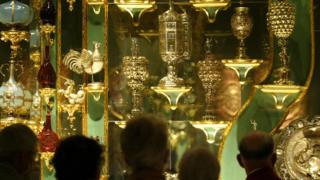 Image copyright
AFP
Image copyright
AFP
Burglars broke into one of Europe's largest treasure collections - the Green Vault in the German city of Dresden - early on Monday, police say.
The popular German daily Bild says the thieves are thought to have grabbed diamonds and other jewels worth millions of euros. The Saxony state authorities have not given details yet.
Dozens of police cars are at the scene and the Green Vault is now shut.
Saxony ruler August the Strong created the collection in the 18th Century.
It is called the Green Vault because some rooms were decorated with malachite-green paint. It is housed in the Residenzschloss - a former royal palace.
The thieves are on the run. At about 05:00 (04:00 GMT) on Monday firefighters were called to tackle a fire at a nearby power distributor. There is speculation that the fire disabled the museum's alarm system.
German media say the thieves apparently twisted back some iron grille bars on a ground floor window to break into the treasury's historic collection, through a small gap.
The most valuable items are in the historic section on the ground floor.
The treasures include a 63.8cm (25-inch) figure of a Moor studded with emeralds and a 648-carat sapphire - a royal gift from Russia's Tsar Peter the Great.
Dresden Prime Minister Michael Kretschmer voiced outrage at the crime, saying "not only were the state art collections burgled, but the people of Saxony too".
"The valuables housed in the Green Vault and Residenzschloss were acquired by people in the Saxony Free State with difficulty, over many centuries." He said the collection was an integral part of Saxony's history.
